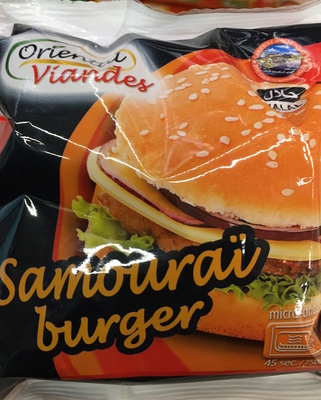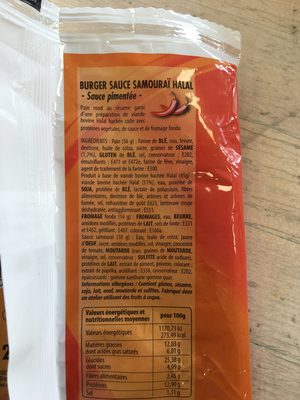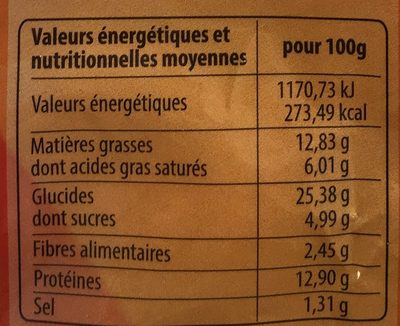Help us make food transparency the norm!
As a non-profit organization, we depend on your donations to continue informing consumers around the world about what they eat.
The food revolution starts with you!
Samouraï Burger - Oriental Viandes - 125 g
Samouraï Burger - Oriental Viandes - 125 g
This product page is not complete. You can help to complete it by editing it and adding more data from the photos we have, or by taking more photos using the app for Android or iPhone/iPad. Thank you!
×
Barcode: 3436590082145 (EAN / EAN-13)
Quantity: 125 g
Packaging: Plastic, Bag, Unfrozen
Brands: Oriental Viandes
Categories: Meats and their products, Meals, Sandwiches, Meals with meat, Hamburgers
Labels, certifications, awards:
Halal, Green Dot, Incorrect data on label, Incorrect nutrition facts on label, fr:Contrôle de la mosquée d'Évry-Courcouronnes


Traceability code: FR 88.218.001 CE - Granges-sur-Vologne (Vosges, France)
Stores: Cora
Countries where sold: France
Matching with your preferences
Health
Ingredients
-
70 ingredients
French: Pain (55 g) : farine de blé, eau, levure, dextrose, huile de colza, sucre, graines de sésame, gluten de blé, sel, farine de fève, émulsifiants : E471, E472e, conservateur : E282, vinaigre, agent de traitement de la farine : E300 Produit à base de viande bovine haché halal (45 g) : viande bovine hachée halal (51%), eau, protéines de soja, protéines de blé, lactate de potassium, fibres alimentaires, dextrose de blé, arômes et arôme de fumée, sel, E621, betterave rouge déshydratée, E551 Fromage fondu (15 g) : fromages, eau, beurre, amidons modifiés, protéines de lait, sels de fonte : E331, E452, gélifiant : E477, colorant : E160a Sauce Samouraï (10 g) : eau, huile de colza, jaune d'œuf, sucre, amidons modifiés, sel, vinaigre, concentré de tomate, moutarde (eau, graines de moutarde, vinaigre, sel, conservateur : sulfite acide de sodium), protéines de lait, extrait de piment, poivron, colorant : extrait de paprika, acidifiant : E334, conservateur : E202, épaississants : gomme xanthane-gomme guar.Allergens: Eggs, Gluten, Milk, Mustard, Sesame seeds, Soybeans, Sulphur dioxide and sulphitesTraces: Nuts
Food processing
-
Ultra processed foods
Elements that indicate the product is in the 4 - Ultra processed food and drink products group:
- Additive: E14XX - Modified Starch
- Additive: E160a - Carotene
- Additive: E160c - Paprika extract
- Additive: E326 - Potassium lactate
- Additive: E415 - Xanthan gum
- Additive: E452 - Polyphosphates
- Additive: E471 - Mono- and diglycerides of fatty acids
- Additive: E472e - Mono- and diacetyltartaric acid esters of mono- and diglycerides of fatty acids
- Additive: E477 - Propane-1‚2-diol esters of fatty acids
- Additive: E551 - Silicon dioxide
- Additive: E621 - Monosodium glutamate
- Ingredient: Colour
- Ingredient: Dextrose
- Ingredient: Emulsifier
- Ingredient: Flavouring
- Ingredient: Gelling agent
- Ingredient: Glucose
- Ingredient: Gluten
- Ingredient: Milk proteins
- Ingredient: Thickener
Food products are classified into 4 groups according to their degree of processing:
- Unprocessed or minimally processed foods
- Processed culinary ingredients
- Processed foods
- Ultra processed foods
The determination of the group is based on the category of the product and on the ingredients it contains.
Additives
-
E160a - Carotene
Carotene: The term carotene -also carotin, from the Latin carota, "carrot"- is used for many related unsaturated hydrocarbon substances having the formula C40Hx, which are synthesized by plants but in general cannot be made by animals -with the exception of some aphids and spider mites which acquired the synthesizing genes from fungi-. Carotenes are photosynthetic pigments important for photosynthesis. Carotenes contain no oxygen atoms. They absorb ultraviolet, violet, and blue light and scatter orange or red light, and -in low concentrations- yellow light. Carotenes are responsible for the orange colour of the carrot, for which this class of chemicals is named, and for the colours of many other fruits, vegetables and fungi -for example, sweet potatoes, chanterelle and orange cantaloupe melon-. Carotenes are also responsible for the orange -but not all of the yellow- colours in dry foliage. They also -in lower concentrations- impart the yellow coloration to milk-fat and butter. Omnivorous animal species which are relatively poor converters of coloured dietary carotenoids to colourless retinoids have yellowed-coloured body fat, as a result of the carotenoid retention from the vegetable portion of their diet. The typical yellow-coloured fat of humans and chickens is a result of fat storage of carotenes from their diets. Carotenes contribute to photosynthesis by transmitting the light energy they absorb to chlorophyll. They also protect plant tissues by helping to absorb the energy from singlet oxygen, an excited form of the oxygen molecule O2 which is formed during photosynthesis. β-Carotene is composed of two retinyl groups, and is broken down in the mucosa of the human small intestine by β-carotene 15‚15'-monooxygenase to retinal, a form of vitamin A. β-Carotene can be stored in the liver and body fat and converted to retinal as needed, thus making it a form of vitamin A for humans and some other mammals. The carotenes α-carotene and γ-carotene, due to their single retinyl group -β-ionone ring-, also have some vitamin A activity -though less than β-carotene-, as does the xanthophyll carotenoid β-cryptoxanthin. All other carotenoids, including lycopene, have no beta-ring and thus no vitamin A activity -although they may have antioxidant activity and thus biological activity in other ways-. Animal species differ greatly in their ability to convert retinyl -beta-ionone- containing carotenoids to retinals. Carnivores in general are poor converters of dietary ionone-containing carotenoids. Pure carnivores such as ferrets lack β-carotene 15‚15'-monooxygenase and cannot convert any carotenoids to retinals at all -resulting in carotenes not being a form of vitamin A for this species-; while cats can convert a trace of β-carotene to retinol, although the amount is totally insufficient for meeting their daily retinol needs.Source: Wikipedia
-
E202 - Potassium sorbate
Potassium sorbate (E202) is a synthetic food preservative commonly used to extend the shelf life of various food products.
It works by inhibiting the growth of molds, yeast, and some bacteria, preventing spoilage. When added to foods, it helps maintain their freshness and quality.
Some studies have shown that when combined with nitrites, potassium sorbate have genotoxic activity in vitro. However, potassium sorbate is generally recognized as safe (GRAS) by regulatory authorities.
-
E222 - Sodium bisulphite
Sodium bisulfite: Sodium bisulfite -or sodium bisulphite- -sodium hydrogen sulfite- is a chemical compound with the chemical formula NaHSO3. Sodium bisulfite is a food additive with E number E222. This salt of bisulfite can be prepared by bubbling sulfur dioxide in a solution of sodium carbonate in water. Sodium bisulfite in contact with chlorine bleach -aqueous solution of sodium hypochlorite- will generate heat and form sodium bisulfate and sodium chloride.Source: Wikipedia
-
E282 - Calcium propionate
Calcium propanoate: Calcium propanoate or calcium propionate has the formula Ca-C2H5COO-2. It is the calcium salt of propanoic acid.Source: Wikipedia
-
E326 - Potassium lactate
Potassium lactate: Potassium lactate is a compound with formula KC3H5O3, or H3C-CHOH-COOK. It is the potassium salt of lactic acid. It is produced by neutralizing lactic acid which is fermented from a sugar source. It has E number "E326". Potassium lactate is a liquid product that is usually 60% solids but is available at up to 78% solids.Potassium lactate is commonly used in meat and poultry products to extend shelf life and increase food safety as it has a broad antimicrobial action and is effective at inhibiting most spoilage and pathogenic bacteria. Potassium lactate is also used as an extinguishing medium in the First Alert Tundra fire extinguishers.Source: Wikipedia
-
E331 - Sodium citrates
Sodium citrate: Sodium citrate may refer to any of the sodium salts of citrate -though most commonly the third-: Monosodium citrate Disodium citrate Trisodium citrateThe three forms of the salt are collectively known by the E number E331. Sodium citrates are used as acidity regulators in food and drinks, and also as emulsifiers for oils. They enable cheeses to melt without becoming greasy.Source: Wikipedia
-
E334 - L(+)-tartaric acid
Tartaric acid: Tartaric acid is a white, crystalline organic acid that occurs naturally in many fruits, most notably in grapes, but also in bananas, tamarinds, and citrus. Its salt, potassium bitartrate, commonly known as cream of tartar, develops naturally in the process of winemaking. It is commonly mixed with sodium bicarbonate and is sold as baking powder used as a leavening agent in food preparation. The acid itself is added to foods as an antioxidant and to impart its distinctive sour taste. Tartaric is an alpha-hydroxy-carboxylic acid, is diprotic and aldaric in acid characteristics, and is a dihydroxyl derivative of succinic acid.Source: Wikipedia
-
E415 - Xanthan gum
Xanthan gum (E415) is a natural polysaccharide derived from fermented sugars, often used in the food industry as a thickening and stabilizing agent.
This versatile food additive enhances texture and prevents ingredient separation in a wide range of products, including salad dressings, sauces, and gluten-free baked goods.
It is considered safe for consumption even at high intake amounts.
-
E471 - Mono- and diglycerides of fatty acids
Mono- and diglycerides of fatty acids (E471), are food additives commonly used as emulsifiers in various processed foods.
These compounds consist of glycerol molecules linked to one or two fatty acid chains, which help stabilize and blend water and oil-based ingredients. E471 enhances the texture and shelf life of products like margarine, baked goods, and ice cream, ensuring a smooth and consistent texture.
It is generally considered safe for consumption within established regulatory limits.
-
E551 - Silicon dioxide
Silicon dioxide: Silicon dioxide, also known as silica, silicic acid or silicic acid anydride is an oxide of silicon with the chemical formula SiO2, most commonly found in nature as quartz and in various living organisms. In many parts of the world, silica is the major constituent of sand. Silica is one of the most complex and most abundant families of materials, existing as a compound of several minerals and as synthetic product. Notable examples include fused quartz, fumed silica, silica gel, and aerogels. It is used in structural materials, microelectronics -as an electrical insulator-, and as components in the food and pharmaceutical industries. Inhaling finely divided crystalline silica is toxic and can lead to severe inflammation of the lung tissue, silicosis, bronchitis, lung cancer, and systemic autoimmune diseases, such as lupus and rheumatoid arthritis. Uptake of amorphous silicon dioxide, in high doses, leads to non-permanent short-term inflammation, where all effects heal.Source: Wikipedia
-
E621 - Monosodium glutamate
Monosodium glutamate: Monosodium glutamate -MSG, also known as sodium glutamate- is the sodium salt of glutamic acid, one of the most abundant naturally occurring non-essential amino acids. Glutamic acid is found naturally in tomatoes, grapes, cheese, mushrooms and other foods.MSG is used in the food industry as a flavor enhancer with an umami taste that intensifies the meaty, savory flavor of food, as naturally occurring glutamate does in foods such as stews and meat soups. It was first prepared in 1908 by Japanese biochemist Kikunae Ikeda, who was trying to isolate and duplicate the savory taste of kombu, an edible seaweed used as a base for many Japanese soups. MSG as a flavor enhancer balances, blends, and rounds the perception of other tastes.The U.S. Food and Drug Administration has given MSG its generally recognized as safe -GRAS- designation. A popular belief is that large doses of MSG can cause headaches and other feelings of discomfort, known as "Chinese restaurant syndrome," but double-blind tests fail to find evidence of such a reaction. The European Union classifies it as a food additive permitted in certain foods and subject to quantitative limits. MSG has the HS code 29224220 and the E number E621.Source: Wikipedia
Ingredients analysis
-
May contain palm oil
Ingredients that may contain palm oil: E471, E472e
-
Non-vegan
Non-vegan ingredients: fr:Viande bovine hachée, Cheese, Butter, Milk proteins, Egg yolk, Milk proteinsSome ingredients could not be recognized.
We need your help!
You can help us recognize more ingredients and better analyze the list of ingredients for this product and others:
- Edit this product page to correct spelling mistakes in the ingredients list, and/or to remove ingredients in other languages and sentences that are not related to the ingredients.
- Add new entries, synonyms or translations to our multilingual lists of ingredients, ingredient processing methods, and labels.
If you would like to help, join the #ingredients channel on our Slack discussion space and/or learn about ingredients analysis on our wiki. Thank you!
-
Non-vegetarian
Non-vegetarian ingredients: fr:Viande bovine hachéeSome ingredients could not be recognized.
We need your help!
You can help us recognize more ingredients and better analyze the list of ingredients for this product and others:
- Edit this product page to correct spelling mistakes in the ingredients list, and/or to remove ingredients in other languages and sentences that are not related to the ingredients.
- Add new entries, synonyms or translations to our multilingual lists of ingredients, ingredient processing methods, and labels.
If you would like to help, join the #ingredients channel on our Slack discussion space and/or learn about ingredients analysis on our wiki. Thank you!
-
Details of the analysis of the ingredients
We need your help!
Some ingredients could not be recognized.
We need your help!
You can help us recognize more ingredients and better analyze the list of ingredients for this product and others:
- Edit this product page to correct spelling mistakes in the ingredients list, and/or to remove ingredients in other languages and sentences that are not related to the ingredients.
- Add new entries, synonyms or translations to our multilingual lists of ingredients, ingredient processing methods, and labels.
If you would like to help, join the #ingredients channel on our Slack discussion space and/or learn about ingredients analysis on our wiki. Thank you!
fr: Pain (farine de _blé_), eau, levure, dextrose, huile de colza, sucre, _graines de sésame_, _gluten_ de blé, sel, farine de fève, émulsifiants (e471), e472e, conservateur (e282), vinaigre, agent de traitement de la farine (e300 Produit à base de viande bovine haché), viande bovine hachée 51%, eau, protéines de _soja_, protéines de _blé_, lactate de potassium, fibres alimentaires, dextrose de blé, arômes, arôme de fumée, sel, e621, betterave rouge, e551 Fromage fondu (_fromages_), eau, _beurre_, amidons modifiés, protéines de _lait_, sels de fonte (e331), e452, gélifiant (e477), colorant (e160a Sauce Samouraï), eau, huile de colza, jaune d'_œuf_, sucre, amidons modifiés, sel, vinaigre, concentré de tomate, _moutarde_ (eau, graines de _moutarde_, vinaigre, sel, conservateur (_sulfite_ acide de sodium)), protéines de _lait_, piment, poivron, colorant (extrait de paprika), acidifiant (e334), conservateur (e202), épaississants (gomme xanthane-gomme guar)- Pain -> en:bread
- farine de _blé_ -> en:wheat-flour - vegan: yes - vegetarian: yes - ciqual_proxy_food_code: 9410
- eau -> en:water - vegan: yes - vegetarian: yes - ciqual_food_code: 18066
- levure -> en:yeast - vegan: yes - vegetarian: yes
- dextrose -> en:dextrose - vegan: yes - vegetarian: yes - ciqual_proxy_food_code: 31016
- huile de colza -> en:colza-oil - vegan: yes - vegetarian: yes - from_palm_oil: no - ciqual_food_code: 17130
- sucre -> en:sugar - vegan: yes - vegetarian: yes - ciqual_proxy_food_code: 31016
- _graines de sésame_ -> en:sesame-seeds - vegan: yes - vegetarian: yes - ciqual_food_code: 15010
- _gluten_ de blé -> en:wheat-gluten - vegan: yes - vegetarian: yes
- sel -> en:salt - vegan: yes - vegetarian: yes - ciqual_food_code: 11058
- farine de fève -> en:broad-bean-flour - vegan: yes - vegetarian: yes - ciqual_proxy_food_code: 9410
- émulsifiants -> en:emulsifier
- e471 -> en:e471 - vegan: maybe - vegetarian: maybe - from_palm_oil: maybe
- e472e -> en:e472e - vegan: maybe - vegetarian: maybe - from_palm_oil: maybe
- conservateur -> en:preservative
- e282 -> en:e282 - vegan: yes - vegetarian: yes
- vinaigre -> en:vinegar - vegan: yes - vegetarian: yes - ciqual_food_code: 11018
- agent de traitement de la farine -> en:flour-treatment-agent
- e300 Produit à base de viande bovine haché -> fr:e300-produit-a-base-de-viande-bovine-hache - labels: en:halal
- viande bovine hachée -> fr:viande-bovine-hachee - labels: en:halal - vegan: no - vegetarian: no - ciqual_proxy_food_code: 6101 - percent: 51
- eau -> en:water - vegan: yes - vegetarian: yes - ciqual_food_code: 18066
- protéines de _soja_ -> en:soy-protein - vegan: yes - vegetarian: yes - ciqual_food_code: 20591
- protéines de _blé_ -> en:wheat-protein - vegan: yes - vegetarian: yes
- lactate de potassium -> en:e326 - vegan: yes - vegetarian: yes
- fibres alimentaires -> en:fiber
- dextrose de blé -> en:wheat-dextrose - vegan: yes - vegetarian: yes - ciqual_proxy_food_code: 31016
- arômes -> en:flavouring - vegan: maybe - vegetarian: maybe
- arôme de fumée -> en:smoke-flavouring - vegan: maybe - vegetarian: maybe
- sel -> en:salt - vegan: yes - vegetarian: yes - ciqual_food_code: 11058
- e621 -> en:e621 - vegan: yes - vegetarian: yes
- betterave rouge -> en:red-beetroot - vegan: yes - vegetarian: yes - ciqual_food_code: 20091
- e551 Fromage fondu -> fr:e551-fromage-fondu
- _fromages_ -> en:cheese - vegan: no - vegetarian: maybe - ciqual_proxy_food_code: 12999
- eau -> en:water - vegan: yes - vegetarian: yes - ciqual_food_code: 18066
- _beurre_ -> en:butter - vegan: no - vegetarian: yes - ciqual_proxy_food_code: 16400
- amidons modifiés -> en:modified-starch - vegan: yes - vegetarian: yes - ciqual_proxy_food_code: 9510
- protéines de _lait_ -> en:milk-proteins - vegan: no - vegetarian: yes
- sels de fonte -> en:emulsifying-salts
- e331 -> en:e331 - vegan: yes - vegetarian: yes
- e452 -> en:e452 - vegan: yes - vegetarian: yes
- gélifiant -> en:gelling-agent
- e477 -> en:e477 - vegan: maybe - vegetarian: maybe
- colorant -> en:colour
- e160a Sauce Samouraï -> fr:e160a-sauce-samourai
- eau -> en:water - vegan: yes - vegetarian: yes - ciqual_food_code: 18066
- huile de colza -> en:colza-oil - vegan: yes - vegetarian: yes - from_palm_oil: no - ciqual_food_code: 17130
- jaune d'_œuf_ -> en:egg-yolk - vegan: no - vegetarian: yes - ciqual_food_code: 22002
- sucre -> en:sugar - vegan: yes - vegetarian: yes - ciqual_proxy_food_code: 31016
- amidons modifiés -> en:modified-starch - vegan: yes - vegetarian: yes - ciqual_proxy_food_code: 9510
- sel -> en:salt - vegan: yes - vegetarian: yes - ciqual_food_code: 11058
- vinaigre -> en:vinegar - vegan: yes - vegetarian: yes - ciqual_food_code: 11018
- concentré de tomate -> en:tomato-concentrate - vegan: yes - vegetarian: yes - ciqual_food_code: 20068
- _moutarde_ -> en:mustard - ciqual_food_code: 11013
- eau -> en:water - vegan: yes - vegetarian: yes - ciqual_food_code: 18066
- graines de _moutarde_ -> en:mustard-seed - vegan: yes - vegetarian: yes - ciqual_food_code: 11013
- vinaigre -> en:vinegar - vegan: yes - vegetarian: yes - ciqual_food_code: 11018
- sel -> en:salt - vegan: yes - vegetarian: yes - ciqual_food_code: 11058
- conservateur -> en:preservative
- _sulfite_ acide de sodium -> en:e222 - vegan: yes - vegetarian: yes
- protéines de _lait_ -> en:milk-proteins - vegan: no - vegetarian: yes
- piment -> en:chili-pepper - vegan: yes - vegetarian: yes - ciqual_food_code: 20151
- poivron -> en:bell-pepper - vegan: yes - vegetarian: yes - ciqual_food_code: 20041
- colorant -> en:colour
- extrait de paprika -> en:e160c - vegan: yes - vegetarian: yes
- acidifiant -> en:acid
- e334 -> en:e334 - vegan: yes - vegetarian: yes
- conservateur -> en:preservative
- e202 -> en:e202 - vegan: yes - vegetarian: yes
- épaississants -> en:thickener
- gomme xanthane-gomme guar -> fr:gomme-xanthane-gomme-guar
Nutrition
-
Poor nutritional quality
⚠ ️Warning: the amount of fruits, vegetables and nuts is not specified on the label, it was estimated from the list of ingredients: 3This product is not considered a beverage for the calculation of the Nutri-Score.
Positive points: 2
- Proteins: 5 / 5 (value: 12.9, rounded value: 12.9)
- Fiber: 2 / 5 (value: 2.45, rounded value: 2.45)
- Fruits, vegetables, nuts, and colza/walnut/olive oils: 0 / 5 (value: 3.125, rounded value: 3.1)
Negative points: 14
- Energy: 3 / 10 (value: 1170.73, rounded value: 1170.7)
- Sugars: 1 / 10 (value: 4.99, rounded value: 5)
- Saturated fat: 5 / 10 (value: 6.01, rounded value: 6)
- Sodium: 5 / 10 (value: 524, rounded value: 524)
The points for proteins are not counted because the negative points are greater or equal to 11.
Nutritional score: (14 - 2)
Nutri-Score:
-
Nutrient levels
-
Fat in moderate quantity (12.8%)
What you need to know- A high consumption of fat, especially saturated fats, can raise cholesterol, which increases the risk of heart diseases.
Recommendation: Limit the consumption of fat and saturated fat- Choose products with lower fat and saturated fat content.
-
Saturated fat in high quantity (6.01%)
What you need to know- A high consumption of fat, especially saturated fats, can raise cholesterol, which increases the risk of heart diseases.
Recommendation: Limit the consumption of fat and saturated fat- Choose products with lower fat and saturated fat content.
-
Sugars in low quantity (4.99%)
What you need to know- A high consumption of sugar can cause weight gain and tooth decay. It also augments the risk of type 2 diabetes and cardio-vascular diseases.
Recommendation: Limit the consumption of sugar and sugary drinks- Sugary drinks (such as sodas, fruit beverages, and fruit juices and nectars) should be limited as much as possible (no more than 1 glass a day).
- Choose products with lower sugar content and reduce the consumption of products with added sugars.
-
Salt in moderate quantity (1.31%)
What you need to know- A high consumption of salt (or sodium) can cause raised blood pressure, which can increase the risk of heart disease and stroke.
- Many people who have high blood pressure do not know it, as there are often no symptoms.
- Most people consume too much salt (on average 9 to 12 grams per day), around twice the recommended maximum level of intake.
Recommendation: Limit the consumption of salt and salted food- Reduce the quantity of salt used when cooking, and don't salt again at the table.
- Limit the consumption of salty snacks and choose products with lower salt content.
-
-
Nutrition facts
Nutrition facts As sold
for 100 g / 100 mlCompared to: Hamburgers Energy 1,170.73 kj
(273 kcal)+26% Fat 12.83 g +10% Saturated fat 6.01 g +57% Carbohydrates 25.38 g +87% Sugars 4.99 g +123% Fiber 2.45 g +28% Proteins 12.9 g -6% Salt 1.31 g -3% Fruits‚ vegetables‚ nuts and rapeseed‚ walnut and olive oils (estimate from ingredients list analysis) 3.125 %
Environment
-
Eco-Score not computed - Unknown environmental impact
We could not compute the Eco-Score of this product as it is missing some data, could you help complete it?Could you add a precise product category so that we can compute the Eco-Score? Add a category
Packaging
-
Packaging with a medium impact
-
Packaging parts
Bag (Plastic)
-
Packaging materials
Material % Packaging weight Packaging weight per 100 g of product Plastic
-
Transportation
-
Origins of ingredients
Missing origins of ingredients information
⚠ ️ The origins of the ingredients of this product are not indicated.
If they are indicated on the packaging, you can modify the product sheet and add them.
If you are the manufacturer of this product, you can send us the information with our free platform for producers.Add the origins of ingredients for this product Add the origins of ingredients for this product
Report a problem
-
Incomplete or incorrect information?
Category, labels, ingredients, allergens, nutritional information, photos etc.
If the information does not match the information on the packaging, please complete or correct it. Open Food Facts is a collaborative database, and every contribution is useful for all.
Data sources
Product added on by tacite
Last edit of product page on by aleene.
Product page also edited by assatadiet, harragastudios, kiliweb, mariacastiel, openfoodfacts-contributors, packbot.











